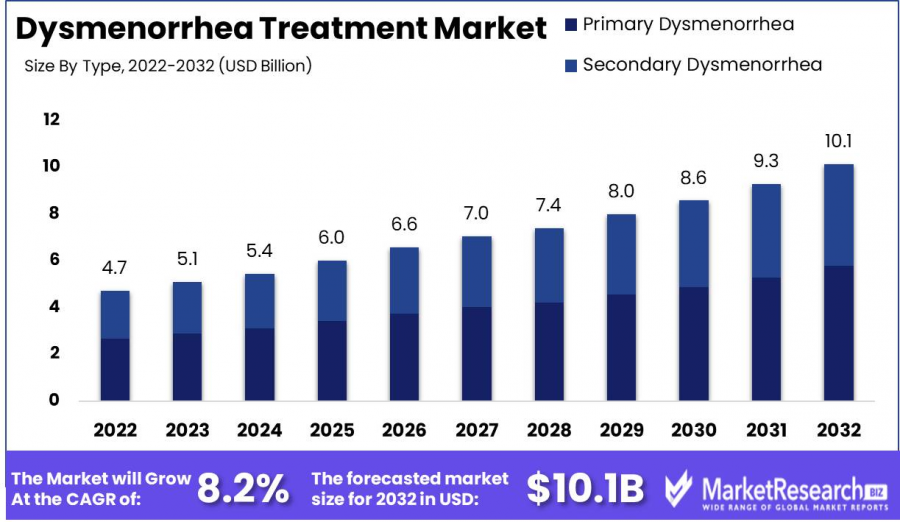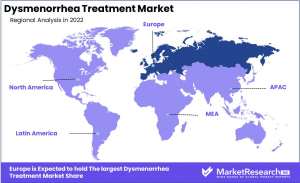
Dysmenorrhea Treatment Market Expected to Achieve USD 10.1 Billion by 2032, Growing at 8.2% CAGR
Dysmenorrhea Treatment Market size is expected to be worth around USD 10.1 Bn by 2032 from USD 4.7 Bn in 2023, growing at a CAGR of 8.2%
NEW YORK CITY, NY, UNITED STATES, February 11, 2025 /EINPresswire.com/ -- Overview
Dysmenorrhea Treatment Market size is expected to be worth around USD 10.1 Bn by 2032 from USD 4.7 Bn in 2023, growing at a CAGR of 8.2% during the forecast period from 2023 to 2032.
Dysmenorrhea, commonly known as painful menstruation, affects a significant percentage of women globally, often interfering with daily activities. As awareness and understanding of this condition grow, advancements in dysmenorrhea treatment offer promising relief options. Treatments range from over-the-counter pain medications and hormonal therapies to innovative non-pharmacological solutions such as acupuncture, heat therapy, and transcutaneous electrical nerve stimulation (TENS).
In recent years, treatments such as IUDs (intrauterine devices) and oral contraceptives have shown increased effectiveness in reducing pain by controlling menstrual flow and stabilizing hormonal fluctuations. NSAIDs (nonsteroidal anti-inflammatory drugs) continue to be a mainstay for short-term relief, offering fast action in managing cramps and related discomfort.
In addition, a growing interest in alternative therapies has prompted the development of herbal supplements and nutritional adjustments designed to alleviate symptoms. Proactive management strategies, including lifestyle changes and early intervention, are increasingly recommended for long-term relief.
With medical advancements and a focus on personalized care, dysmenorrhea treatments are becoming more accessible and effective, improving the quality of life for women worldwide. As further research continues, the future of dysmenorrhea management holds even greater promise for those suffering from this common yet impactful condition.
Click here to get a Sample report copy @ https://marketresearch.biz/report/dysmenorrhea-treatment-market/request-sample/
Key Takeaways
•Prevalence of Dysmenorrhea: Dysmenorrhea affects a significant portion of women globally, with primary dysmenorrhea being the most common form, impacting approximately 50-90% of women of reproductive age.
•Pharmacological Dominance: NSAIDs and hormonal contraceptives remain the leading treatments, providing effective pain relief and symptom control for many women.
•Rising Preference for Non-Pharmacological Options: Non-invasive treatments like TENS therapy, acupuncture, and lifestyle changes are gaining popularity due to fewer side effects and holistic approaches.
•Increased Adoption of Hormonal IUDs: The levonorgestrel-releasing intrauterine system (LNG-IUS) is widely used, providing long-term pain relief by regulating menstrual cycles and reducing flow.
•Advancements in Research: Ongoing clinical studies are focused on improving treatment efficacy, exploring alternative therapies, and identifying new drug options for those who do not respond to conventional treatments.
•Growing Market Potential: The global dysmenorrhea treatment market is expected to expand as more women seek personalized, effective, and accessible treatment solutions, especially in emerging markets.
Segmentation Analysis
•Type Analysis: Dysmenorrhea is categorized into primary and secondary types, with primary dysmenorrhea being the most common, affecting about 50% of women globally. It is less severe compared to secondary dysmenorrhea, which is caused by underlying medical conditions. The primary dysmenorrhea segment currently dominates the treatment market and is expected to maintain its leadership due to rising awareness, increased treatment options, and higher prevalence. Economic growth in emerging markets also drives the demand for effective treatments.
•Treatment Analysis: Non-pharmacological treatments, including natural remedies, acupuncture, and exercise, lead the global dysmenorrhea treatment market. Many women seek these alternatives to manage their symptoms without pharmaceuticals. This trend is particularly strong in emerging economies, where women are becoming more aware of menstrual health and alternative treatment options. As awareness increases and healthcare access improves, demand for natural therapies and non-pharmacological treatments continues to grow, contributing to the market’s expansion.
•Distribution Channel Analysis: Retail pharmacies are the dominant distribution channel for dysmenorrhea treatments, providing easy access to various treatment options. Pharmaceutical companies often collaborate with these pharmacies to distribute their products, further strengthening the segment’s market share. As emerging economies continue to develop, demand for healthcare services, including retail pharmacies, is rising. This growth is contributing to an increase in the number of retail pharmacies, boosting the distribution of dysmenorrhea treatments and supporting the segment’s continued dominance.
Market Segments
By Type
•Primary Dysmenorrhea
•Secondary Dysmenorrhea
By Treatment
•Non-Pharmacological Treatment
•Heat Therapy
•Dietary Modifications
•Other Non-Pharmacological Treatment
•Pharmacological Treatment
•Nonsteroidal Anti-Inflammatory Drugs (NSAIDs)
•Oral Contraceptives
•Analgesics
•Hormonal Therapies
By Distribution Channel
•Hospitals and Clinics
•Retail Pharmacies
•Online Platforms
To Purchase this Premium Report@ https://marketresearch.biz/purchase-report/?report_id=37949
Market Dynamics
•Driver: Increased Awareness and Education: Growing awareness and education about dysmenorrhea are significant drivers of the treatment market. As more women recognize the symptoms and seek medical advice, the demand for effective treatments rises. Educational initiatives by healthcare organizations and governments have been instrumental in informing women about menstrual health, leading to earlier diagnosis and intervention. This proactive approach not only improves individual health outcomes but also reduces the societal burden of untreated menstrual disorders.
•Trend: Integration of Alternative Therapies: There is a notable trend toward integrating alternative therapies in managing dysmenorrhea. Practices such as acupuncture, herbal remedies, and dietary modifications are gaining popularity among women seeking non-pharmacological options. This shift is partly due to concerns about the side effects of conventional medications and a desire for holistic approaches to health. Healthcare providers are increasingly acknowledging the role of these therapies, leading to more comprehensive treatment plans that cater to individual preferences and needs.
•Restraint: Limited Access to Healthcare Services: A significant restraint in the dysmenorrhea treatment market is the limited access to healthcare services, particularly in rural and underserved areas. Many women lack access to specialized care, leading to underdiagnosis and undertreatment of menstrual disorders. This disparity is exacerbated by socioeconomic factors, including income inequality and lack of health insurance. Addressing these access issues is crucial for improving health outcomes and ensuring that all women receive appropriate care for dysmenorrhea.
•Opportunity: Development of Personalized Medicine: Advancements in personalized medicine present a significant opportunity for the treatment of dysmenorrhea. By tailoring treatments to individual genetic profiles and specific health conditions, healthcare providers can enhance efficacy and minimize side effects. This approach aligns with the growing trend toward precision medicine, offering the potential for more effective and individualized care strategies. Investing in research to develop and implement personalized treatment plans could revolutionize dysmenorrhea management.
Market Key Players
•Bayer AG
•Pfizer Inc.
•Johnson & Johnson
•Sanofi S.A.
•Novartis International AG
•GlaxoSmithKline plc
•Cipla
•AbbVie
•Teva Pharmaceutical Industries Ltd.
•Viatris
•Eli Lilly and Company
•Other
Regional Analysis
Dysmenorrhea, a prevalent menstrual disorder characterized by painful menstruation, affects millions of women globally, with an estimated one in four women experiencing symptoms. While many women manage the condition with over-the-counter (OTC) pain relief medications, there is a growing demand for prescription-only treatments that provide more effective and long-lasting relief.
Europe has emerged as the dominant region in the dysmenorrhea treatment market. The presence of pharmaceutical companies specializing in women’s health has contributed to the development of highly effective dysmenorrhea treatments tailored to manage symptoms effectively.
The market in Europe is projected to experience significant growth in the coming years. This expansion is driven by factors such as increased awareness of dysmenorrhea, rising disposable income, and a higher prevalence of the condition. Additionally, the availability of a wide range of effective treatment options continues to support the growing demand for dysmenorrhea solutions, solidifying Europe’s position as the leader in this market.
Emerging Trends in Dysmenorrhea Treatment
Pharmacological Treatments
- Non-Steroidal Anti-Inflammatory Drugs (NSAIDs): NSAIDs, such as ibuprofen and naproxen, remain the first-line treatment for primary dysmenorrhea. They alleviate pain by inhibiting prostaglandin production, which is responsible for uterine contractions. However, approximately 18% of women experience minimal or no relief from NSAIDs, indicating a need for alternative therapies.
- Hormonal Contraceptives: Oral contraceptives, hormonal intrauterine devices (IUDs), and implants are utilized to suppress ovulation and reduce menstrual flow, thereby decreasing pain. The levonorgestrel-releasing intrauterine system (LNG-IUS) has shown effectiveness in treating dysmenorrhea across various age groups, including adolescents.
Non-Pharmacological Treatments
- Transcutaneous Electrical Nerve Stimulation (TENS): TENS therapy involves applying electrical currents to the skin to reduce pain perception. Studies have demonstrated its effectiveness in alleviating menstrual pain, with improvements in reported pain levels and decreased use of analgesics.
- Acupuncture and Acupressure: These traditional Chinese medicine techniques have been explored for their potential to reduce menstrual pain. While some studies suggest benefits, the evidence remains inconclusive, and further research is needed to establish their efficacy.
- Lifestyle Modifications: Regular physical activity, dietary adjustments, and stress management techniques have been associated with reduced menstrual pain severity. Incorporating exercise into daily routines can lead to significant improvements in pain management.
Use Cases in Dysmenorrhea Treatment
Primary Dysmenorrhea Management:
- NSAIDs: Widely used to manage primary dysmenorrhea, NSAIDs provide effective pain relief for many women. However, their efficacy is limited in about 18% of cases, necessitating alternative treatments.
- Hormonal Contraceptives: For women seeking contraception, hormonal methods not only prevent pregnancy but also alleviate menstrual pain by regulating menstrual cycles and reducing flow.
Secondary Dysmenorrhea Management:
- Endometriosis: In cases where dysmenorrhea is secondary to endometriosis, hormonal therapies such as combined oral contraceptives or progestin-only methods are effective in reducing pain and controlling disease progression.
- Adenomyosis: For adenomyosis-related pain, hormonal IUDs like the LNG-IUS have been shown to reduce symptoms by decreasing menstrual bleeding and uterine contractions.
Alternative Therapies:
- TENS Therapy: Utilized as a non-invasive option, TENS therapy has been effective in reducing menstrual pain intensity and duration, offering an alternative for those who prefer non-pharmacological interventions.
- Acupuncture and Acupressure: While evidence is mixed, some women find relief from menstrual pain through acupuncture and acupressure, highlighting the need for personalized treatment approaches.
Lawrence John
Prudour
+91 91308 55334
email us here
Distribution channels: Healthcare & Pharmaceuticals Industry
Legal Disclaimer:
EIN Presswire provides this news content "as is" without warranty of any kind. We do not accept any responsibility or liability for the accuracy, content, images, videos, licenses, completeness, legality, or reliability of the information contained in this article. If you have any complaints or copyright issues related to this article, kindly contact the author above.
Submit your press release


